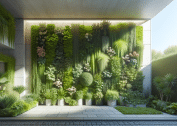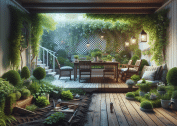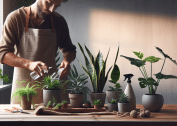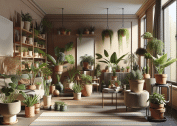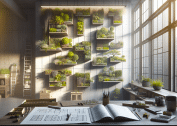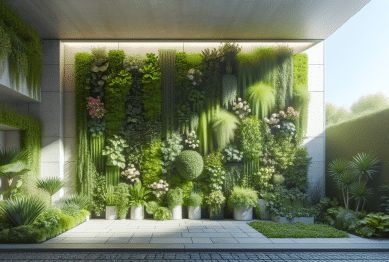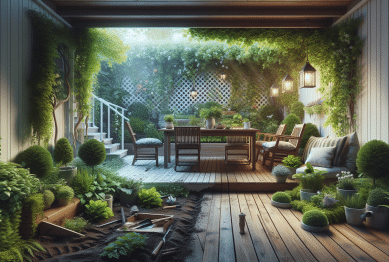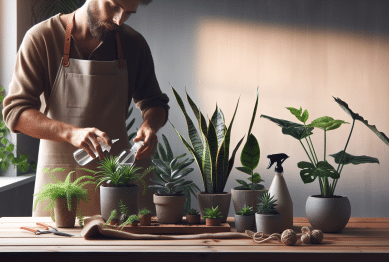Uncover why some indoor plants flourish while others struggle in the same room. This guide reveals hidden techniques for healthy, vibrant houseplants and explores how lighting, watering, soil choices, and environment can make all the difference in your home greenery journey.
Understanding Light and Its Impact on Houseplants
Light is one of the most overlooked factors in keeping indoor plants healthy and resilient. Each species comes with unique needs—some crave bright sunlight, while others thrive in shaded corners. It’s not just about quantity; the quality and angle of light matter deeply. Furniture placement, window treatments, and even neighboring buildings can influence how much sunlight your plants receive indoors. For many popular indoor plants, indirect light is ideal, but if your living space is particularly dim, supplementing with grow lights might make a noticeable difference in your results. The spectrum and intensity of artificial lights imitate the sun’s rays, supporting photosynthesis in conditions that would otherwise be challenging for greenery to survive. Setting up a simple full-spectrum light can allow even fussy varieties to thrive in spaces traditionally unsuited for plants.
Assessing your home’s natural light is essential. South-facing windows typically provide the most intense sun, perfect for sun-loving species, while north-facing ones suit shade-tolerant plants. Avoid placing sensitive plants in direct midday sunlight—this can cause leaf burn or faded foliage over time. Observe how shadows move across your space during the day to identify the best locations for specific species. Using sheers or blinds can soften harsh rays. Tracking the changing angle of the sun throughout different seasons is helpful, as bright summer exposures may shift to muted winter gloom. Matching plant placements to these conditions supports consistent growth and lessens common stress-related issues like yellowing leaves or stunted development.
Artificial lighting becomes a game-changer for plant enthusiasts without access to natural sunbeams. LED and fluorescent grow lights are energy-efficient and customizable, allowing you to optimize conditions for various plants year-round. Schedule lights for 12-16 hours per day for best results, mimicking natural daylight. Experimenting with timers keeps routines regular, and combining both sunlight and supplemental lighting means even windowless rooms can support lush, green displays. When approached with intention, lighting choices are one of the most powerful ways to help your indoor jungle flourish. https://www.urban.org/research/publication/indoor-lighting-and-plants
Mastering the Art of Watering Indoor Greens
Watering is a subtle but critical aspect of successful indoor gardening. Both overwatering and underwatering can prove disastrous, leading to root rot or wilting. Many homeowners mistakenly use a strict schedule, but it’s wiser to check the actual moisture in the soil before watering. Dig down a few centimeters with your finger—a damp, earthy feel suggests holding off, while dryness signals it’s time to water.
Matching watering frequency to a plant’s species, pot size, and seasonal rhythms encourages optimal health. For example, succulents and cacti thrive in dry conditions and need infrequent deep waterings, while tropical varieties prefer consistently moist soil. In winter, many indoor plants enter a dormant period and require less water. Conversely, spring and summer growth spurts increase demand. Using pots with drainage holes is essential. This prevents water from pooling at roots, a situation that most commonly leads to plant stress and decay. Watering in the morning gives plants a full day to absorb moisture and decreases the odds of fungal problems.
Consider the water source as well; some plants are sensitive to the chlorine or minerals found in tap water. Allowing tap water to sit overnight or using filtered water can reduce harm for fussy species. Bottom-watering—where pots absorb moisture from a tray—helps roots access water directly and prevents oversaturation on the surface. Monitoring leaf color, turgidity, and new growth can also signal if your schedule is aligned with your plant’s needs. A little observation goes a long way, revealing patterns that allow both novice and experienced indoor gardeners to adapt confidently. https://hgic.clemson.edu/factsheet/watering-indoor-plants/
Picking the Right Soil and Containers for Growth
The right soil and container can mean the difference between a flourishing houseplant and a constant headache. Each indoor species has preferences when it comes to drainage, nutrients, and structure. Standard potting mix may suffice for many, but specialty blends (like orchid bark or succulent sand mixes) cater to particular needs. Avoid garden soil indoors, as it often lacks the aeration and drainage required and may harbor pests. Containers should always feature drainage holes—this small feature alone will spare most plants from the perils of waterlogged roots.
Soil amendments such as perlite, vermiculite, and coconut coir can be mixed in to improve airflow and water retention. This is particularly useful in homes with either extremely dry or humid air, as amendments help balance the amount of moisture plants retain between waterings. Repotting every year or two refreshes depleted soil, removes salt buildup from fertilizers, and gives roots space to expand. Choose a slightly larger pot when repotting, but avoid oversized containers—the excess soil can trap water and suffocate delicate roots. Selecting the correct materials for containers also matters: terracotta breathes well and suits arid climates, while glazed ceramic holds more moisture for thirsty varieties.
Decorative containers without drainage can still be used as “cachepots”—simply keep the plant in a plastic grow pot, and slip it inside the decorative shell. This technique provides the visual appeal of stylish planters while retaining critical drainage and airflow. Monitor the soil level regularly, as decorative pots can sometimes hide standing water, leading to hidden root problems. With a mindful approach to soil and containers, your indoor plants are more likely to adapt quickly, establish robust roots, and produce the vibrant foliage every plant parent craves. https://extension.psu.edu/choosing-soil-and-containers-for-your-houseplants
Humidity, Temperature, and Their Role in Plant Health
Indoor climate plays a surprisingly significant role in plant success. Many favorite houseplants originate from tropical environments where humidity and consistent warmth are the norm. Dry air, especially in homes heated during colder months, can stress plants and cause browning leaf edges or leaf drop. Using humidifiers, pebble trays with water, or grouping plants together raises ambient moisture, emulating jungle-like surroundings and helping ferns, monstera, and calathea varieties flourish indoors.
Temperature fluctuations can also impact growth and vitality. Avoid placing plants near radiators, air vents, or drafty windows, as sudden changes stress delicate roots and foliage. Most indoor varieties prefer even temperatures between 65°F and 75°F (18°C to 24°C). Nighttime drops or hot gusts from heaters can be just as damaging as outright neglect. For challenging climates, some homeowners set up microclimates—small, controlled environments with steady temperature and humidity tailored for certain groups of plants—offering reliable conditions year-round.
Monitoring humidity and temperature with simple home devices helps tailor care routines. If air is very dry, misting leaves (provided species tolerate it) adds a short-term boost, though sustainable results come from more permanent solutions like room humidifiers. Balancing these factors is a science, but the reward is healthy, glossy foliage that resists pests and disease naturally. A little environmental adjustment can quickly transform a languishing plant into a thriving room centerpiece. https://www.rhs.org.uk/advice/profile?PID=868
Nutrition for Indoor Plants: Getting Fertilization Right
While soil provides a foundational mix of nutrients, most indoor plants benefit from additional fertilization through the growing season. The right type and timing of fertilizer support robust foliage, strong roots, and vibrant blooms. General-purpose liquid fertilizers suit most houseplants, while tailored blends (like cactus food or orchid-specific mixes) ensure optimal nutrition for specialty varieties. It pays to fertilize less in winter, as most indoor plants naturally slow their growth and require fewer inputs during this resting phase.
Signs of nutrient deficiency include pale or yellowing leaves, stunted growth, and reduced flowering. Overfertilization can be equally harmful, causing root burn or salt buildup. Diluting fertilizer to half strength and applying no more than every two to four weeks allows plants to absorb nutrients gradually without overwhelming fragile roots. Periodic flushing with clear water also helps reduce the buildup of unused minerals, especially in pots without frequent soil changes. Choosing organic or slow-release fertilizers can minimize the risk of accidental burns and provide a steady nutrient supply between feedings.
Observing plant response and adapting your regimen is crucial. With practice, it becomes intuitive to sense when an indoor plant is hungry for a nutritional boost versus needing a break. This attentiveness ensures lush, leafy displays and supports natural pest and disease resistance. Fertilization, paired with strong fundamentals in light, water, and soil, forms a holistic care routine that keeps your houseplants looking their best every season. https://extension.umn.edu/houseplants/fertilizing-houseplants
Solving Common Indoor Plant Problems
Even with careful care, challenges arise in maintaining houseplants indoors. The most frequent complaints include droopy leaves, pests, and mysterious brown spots. Often, correcting environmental conditions like lighting, watering, or humidity quickly reverses these issues. For persistent problems, isolating the affected plant helps prevent the spread of pests or diseases to your entire collection. Early intervention—like removing dead material, rinsing leaves, or repotting in fresh soil—can save a struggling specimen from further decline.
Pests such as spider mites, aphids, and fungus gnats are common in indoor settings. These unwelcome guests often sneak in through new plants or potting soil and multiply rapidly in the absence of natural predators. Routine inspections and prompt action—such as spraying with insecticidal soap, wiping leaves, or using sticky traps—keep populations in check. Natural treatments and biological controls are available for serious infestations, minimizing the need for harsh chemicals in your living space. Always isolate and monitor new purchases for a few weeks to safeguard your existing indoor garden.
Sometimes houseplant woes are subtle. Leggy stems, faded foliage, or slow growth may signal inadequate lighting, irregular watering, or the need for a larger container. A little detective work and willingness to experiment often lead to solutions, unlocking vibrant growth and renewed vitality. Houseplants bring beauty, cleaner air, and a sense of accomplishment—nurturing them can be as rewarding as the lush results they produce. https://www.gardeners.com/how-to/indoor-plant-problems/6669.html
References
1. Clemson Cooperative Extension. (n.d.). Watering Indoor Plants. Retrieved from https://hgic.clemson.edu/factsheet/watering-indoor-plants/
2. University of Minnesota Extension. (n.d.). Fertilizing Houseplants. Retrieved from https://extension.umn.edu/houseplants/fertilizing-houseplants
3. Penn State Extension. (n.d.). Choosing Soil and Containers for Your Houseplants. Retrieved from https://extension.psu.edu/choosing-soil-and-containers-for-your-houseplants
4. Royal Horticultural Society. (n.d.). Houseplant Care. Retrieved from https://www.rhs.org.uk/advice/profile?PID=868
5. Gardeners Supply Company. (n.d.). Indoor Plant Problems: Help for Gardening Indoors. Retrieved from https://www.gardeners.com/how-to/indoor-plant-problems/6669.html
6. Urban Institute. (n.d.). Indoor Lighting and Plants. Retrieved from https://www.urban.org/research/publication/indoor-lighting-and-plants


